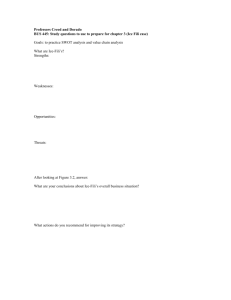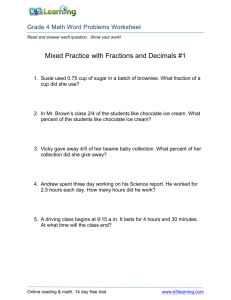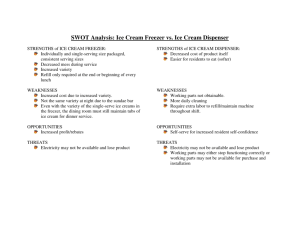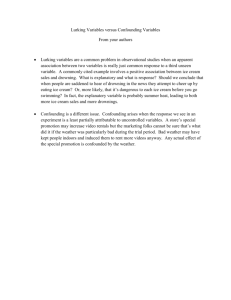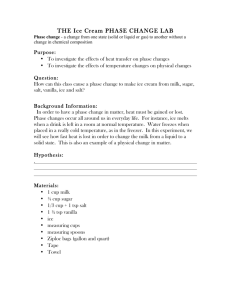Ice Cream Lab: Phase Change Experiment Worksheet
advertisement
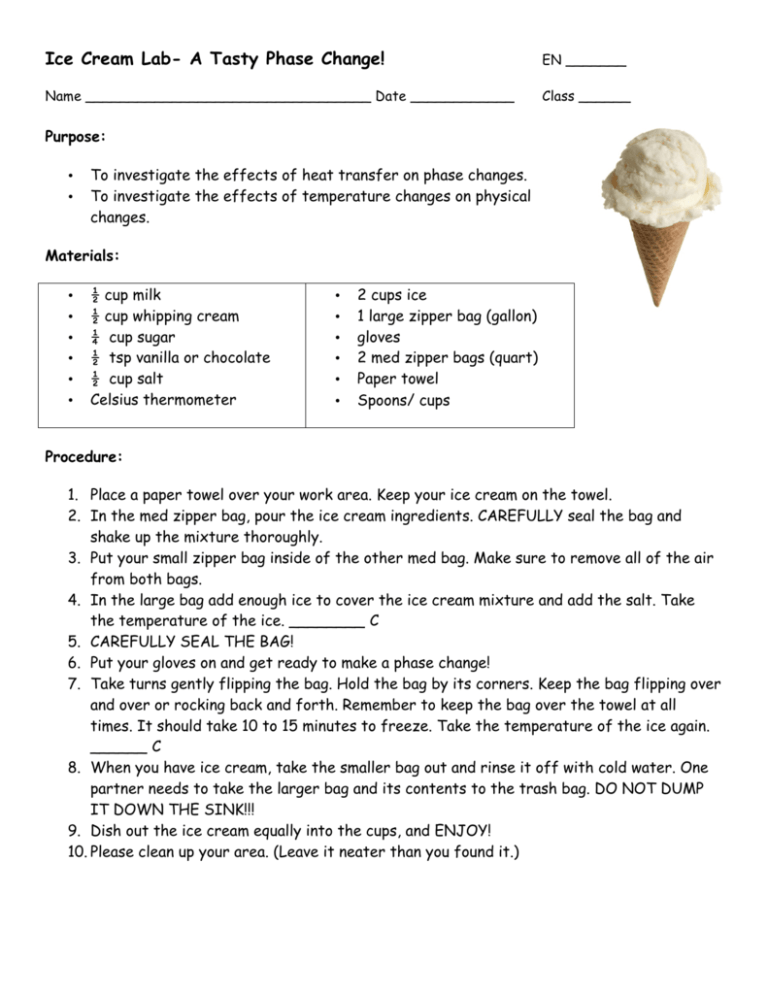
Ice Cream Lab- A Tasty Phase Change! EN _______ Name _________________________________ Date ____________ Class ______ Purpose: • • To investigate the effects of heat transfer on phase changes. To investigate the effects of temperature changes on physical changes. Materials: • • • • • • ½ cup milk ½ cup whipping cream ¼ cup sugar ½ tsp vanilla or chocolate ½ cup salt Celsius thermometer • • • • • • 2 cups ice 1 large zipper bag (gallon) gloves 2 med zipper bags (quart) Paper towel Spoons/ cups Procedure: 1. Place a paper towel over your work area. Keep your ice cream on the towel. 2. In the med zipper bag, pour the ice cream ingredients. CAREFULLY seal the bag and shake up the mixture thoroughly. 3. Put your small zipper bag inside of the other med bag. Make sure to remove all of the air from both bags. 4. In the large bag add enough ice to cover the ice cream mixture and add the salt. Take the temperature of the ice. ________ C 5. CAREFULLY SEAL THE BAG! 6. Put your gloves on and get ready to make a phase change! 7. Take turns gently flipping the bag. Hold the bag by its corners. Keep the bag flipping over and over or rocking back and forth. Remember to keep the bag over the towel at all times. It should take 10 to 15 minutes to freeze. Take the temperature of the ice again. ______ C 8. When you have ice cream, take the smaller bag out and rinse it off with cold water. One partner needs to take the larger bag and its contents to the trash bag. DO NOT DUMP IT DOWN THE SINK!!! 9. Dish out the ice cream equally into the cups, and ENJOY! 10. Please clean up your area. (Leave it neater than you found it.) Conclusion Questions: 1. What state of matter was the milk when you began? __________________________ 2. What state of matter was the milk when you were done? _______________________ 3. Is the phase change of the milk an Endothermic or Exothermic process? (circle one) 4. In which direction did heat flow? From the _______________________ to the ________________________. 5. Compare the temperature of the ice before and after the experiment. Explain your observations. 6. Why was the salt added to the ice in this experiment? 7. Describe the phase change that you observed in the ice say whether it is an endo or exothermic process. 8. Where did the energy to melt the ice come from? __________________________ 9. Why did the milk freeze? 10. Describe the motion of the molecules in milk vs ice cream. 11. Would the milk have frozen if you used just plain ice with not salt? Explain. 12. If you had added more sugar to the milk, would the ice cream have frozen faster or more slowly? Why? 13. As the ice cream is forming, would you expect the mixture to get colder or stay the same temperature? Explain. 14. Why did the outside of the bag get wet? (Assume that your bag did not spring a leak.) Is this an endo or exothermic process? 15. Label the diagram with the contents and phase changes. Complete the bold lines in the diagram to make them arrows that indicate the heat/energy flow. Contents Contents HEAT HEAT Phase Change Contents Phase Change Phase Change Extension: 16. Why is salt spread on the roads before a winter storm? • • • • 2 tablespoons sugar 1 cup half and half 1/2 teaspoon vanilla extract 1/2 cup salt (The bigger the granules, the better. Kosher or rock salt works best, but table salt is fine.) http://galileo.phys.virginia.edu/outreach/8thgradesol/TastyPhaseChange.htm Explanation Procedure 1. Add 1/4 cup sugar, 1/2 cup milk, 1/2 cup whipping cream, and 1/4 teaspoon vanilla to the quart ziplocTM bag. Seal the bag securely. 2. Put 2 cups of ice into the gallon ziplocTM bag. 3. Use a thermometer to measure and record the temperature of the ice in the gallon bag. 4. Add 1/2 to 3/4 cup salt (sodium chloride) to the bag of ice. 5. Place the sealed quart bag inside the gallon bag of ice and salt. Seal the gallon bag securely. 6. Gently rock the gallon bag from side to side. It's best to hold it by the top seal or to have gloves or a cloth between the bag and your hands because the bag will be cold enough to damage your skin. 7. Continue to rock the bag for 10-15 minutes or until the contents of the quart bag have solidified into ice cream. 8. Open the gallon bag and use the thermometer to measure and record the temperature of the ice/salt mixture. 9. Remove the quart bag, open it, serve the contents into cups with spoons and ENJOY! Explanation Ice has to absorb energy in order to melt, changing the phase of water from a solid to a liquid. When you use ice to cool the ingredients for ice cream, the energy is absorbed from the ingredients and from the outside environment (like your hands, if you are holding the baggie of ice!). When you add salt to the ice, it lowers the freezing point of the ice, so even more energy has to be absorbed from the environment in order for the ice to melt. This makes the ice colder than it was before, which is how your ice cream freezes. Ideally, you would make your ice cream using 'ice cream salt', which is just salt sold as large crystals instead of the small crystals you see in table salt. The larger crystals take more time to dissolve in the water around the ice, which allows for even cooling of the ice cream. You could use other types of salt instead of sodium chloride, but you couldn't substitute sugar for the salt because (a) sugar doesn't dissolve well in cold water and (b) sugar doesn't dissolve into multiple particles, like an ionic material such as salt. Compounds that break into two pieces upon dissolving, like NaCl breaks into Na+ and Cl-, are better at lowering the freezing point than substances that don't separate into particles because the added particles disrupt the ability of the water to form crystalline ice. The more particles there are, the greater the disruption and the greater the impact on particle-dependent properties (colligative properties) like freezing point depresssion, boiling point elevation, and osmotic pressure. The salt causes the ice to absorb more energy from the environment (becoming colder), so although it lowers the point at which water will re-freeze into ice, you can't add salt to very cold ice and expect it to freeze your ice cream or de-ice a snowy sidewalk (water has to be present!). This is why NaCl isn't used to de-ice sidewalks in areas that are very cold. chemistry.about.com/cs/howtos/a/aa020404a.htm Brain “Freezer” A group of children went to Holman’s Dairy to buy ice cream cones. Each child bought a double scoop cone with two flavors of ice cream. None of the children chose the same combination of flavors. Holman’s Dairy has nine different flavors of ice cream: Vanilla, Maple, Chocolate, Toffee, Raspberry, Strawberry, Jamocha, Nutcracker, and Almond. How many children are there? http://teachnet.com/lessonplans/science/plastic-bag-ice-cream-recipe/ 1. What happened shortly after you added the salt to the ice cubes? Was the temperature above or below the freezing temperature for water? (The ice started to melt as the salt ions broke apart and interfered with the crystal lattice of the water molecules bonds. The ice water that is formed is actually below freezing: super-cooled.) 2. What is the only factor that could have caused the changes shown in question 1? What does this tell you about the freezing point temperature of salt water compared to fresh water? (The breaking of bonds requires an addition of energy which comes from the ice. The ionic compound breaking down during the addition of the salt and ice. The freezing point temperature of salt water is less than that of fresh water.) 3. Heat energy is needed to change phase from a solid to a liquid. List the possible sources of the heat needed for this phase change in your baggie. Which source do you think is the best possibility and why? (The ice, the milk, the salt, the air in the baggie, the heat from your hands. The milk is the best source of heat energy for the melting process because it is a liquid and stores more energy for the phase change than the air or salt do. Your hands do not touch enough area to be effective sources of heat.) 4. In looking at the temperature changes shown on your data table, explain how the energy flow of the baggie system resulted in your tasty treat for an end product. Where is the energy flowing from and where is it going to? (The energy flows from the milk to the ice. This removes enough energy to bring about a phase change from liquid to solid.) 5. In the radiator of your car you put a combination of antifreeze and water to keep your car engine cool in the summer and prevent the radiator from freezing in the winter. Explain how you think this works in terms of what you saw in the experiment you just did. (The material added in the antifreeze to the water in radiators interferes with the bonding of water molecules and the formation of the solid crystal lattice for ice. This will allow the water to stay in a liquid form to circulate through the engine and absorb the heat from the engine. In the summer, the same material raises the boiling point of the water and keeps the very hot water from going to a vapor phase. This allows the water to circulate and absorb even more heat energy from the engine – cooling your motor.) http://www.thirteen.org/edonline/ntti/resources/lessons/s_freeze/freeze3.pdf
